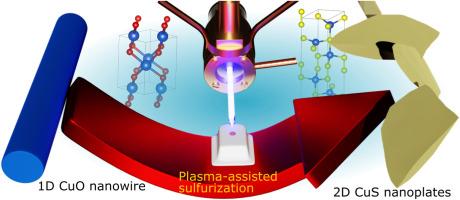Plasma-driven 1D to 2D nanomaterial phase transition
IF 8.2
2区 材料科学
Q1 MATERIALS SCIENCE, MULTIDISCIPLINARY
引用次数: 0
Abstract
The increasing demand for novel nanomaterials in nanotechnology requires innovative techniques to adapt their properties and morphologies, highlighting the importance of strategies for controlled conversions between different material morphologies. This research reveals a unique plasma-assisted anion-exchange phase transformation which facilitates the conversion from 1D model of copper oxide nanowires into 2D copper sulfide. Our investigation reveals that plasma-assisted sulfurization triggers the onset of 2D structure evolution from the original nanowire, followed by the complete conversion of the original 1D copper oxide into 2D copper sulfide. This dimensionality transformation is likely driven by the accumulation of surface charges in the plasma environment, particularly increased in regions of heightened curvatures in the nascent copper sulfide phase. The enhanced electric field in these zones directs the flow of charged plasma species to these specific regions. In addition, the preferential adsorption of sulfur species at the edges of the nanoplates drives the diffusion of copper ions from the core of the nanowires outward to the edges of the forming nanoplates, where sulfurization predominantly occurs. These suggestions were supported by theoretical modeling of the processes. The morphology of the transformed nanowires depends on the original diameter of the nanowires and the duration of the treatment. Finally, the study highlights the potential of plasma-assisted techniques for advanced processing of nanomaterials, enabling precise and distinct nanomodifications.

等离子体驱动的一维到二维纳米材料相变
纳米技术对新型纳米材料日益增长的需求需要创新的技术来适应它们的性质和形态,这突出了在不同材料形态之间控制转换策略的重要性。该研究揭示了一种独特的等离子体辅助阴离子交换相变,有助于将氧化铜纳米线的一维模型转化为二维硫化铜。我们的研究表明,等离子体辅助硫化触发了从原始纳米线开始的二维结构演变,随后将原始的一维氧化铜完全转化为二维硫化铜。这种维度转变可能是由等离子体环境中表面电荷的积累所驱动的,特别是在新生硫化铜阶段曲率增大的区域。这些区域的增强电场引导带电等离子体流向这些特定区域。此外,硫在纳米板边缘的优先吸附,促使铜离子从纳米线的核心向外扩散到形成纳米板的边缘,在那里主要发生硫化。这些建议得到了过程理论建模的支持。转化纳米线的形态取决于纳米线的原始直径和处理时间。最后,该研究强调了等离子体辅助技术在纳米材料高级加工中的潜力,使精确和独特的纳米修饰成为可能。
本文章由计算机程序翻译,如有差异,请以英文原文为准。
求助全文
约1分钟内获得全文
求助全文
来源期刊

Materials Today Nano
Multiple-
CiteScore
11.30
自引率
3.90%
发文量
130
审稿时长
31 days
期刊介绍:
Materials Today Nano is a multidisciplinary journal dedicated to nanoscience and nanotechnology. The journal aims to showcase the latest advances in nanoscience and provide a platform for discussing new concepts and applications. With rigorous peer review, rapid decisions, and high visibility, Materials Today Nano offers authors the opportunity to publish comprehensive articles, short communications, and reviews on a wide range of topics in nanoscience. The editors welcome comprehensive articles, short communications and reviews on topics including but not limited to:
Nanoscale synthesis and assembly
Nanoscale characterization
Nanoscale fabrication
Nanoelectronics and molecular electronics
Nanomedicine
Nanomechanics
Nanosensors
Nanophotonics
Nanocomposites
 求助内容:
求助内容: 应助结果提醒方式:
应助结果提醒方式:


